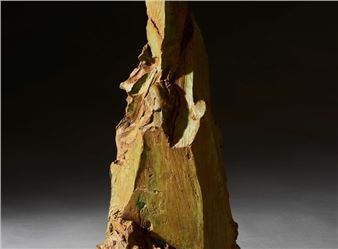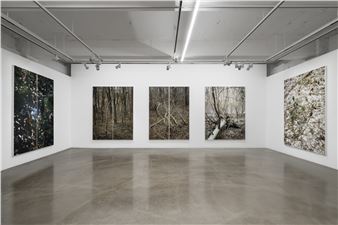Tunji Adeniyi-Jones: Immersions
Debuting a new series of paintings, Tunji Adeniyi-JonesвҖҷs solo exhibition вҖҳImmersionsвҖҷ explores the diasporic body, African subjecthood and autonomy. Born and educated in the UK and now based in New York, Adeniyi-Jones draws on his Yoruba heritage, the ancient history of West Africa and its mythology, as well as the Black American culture of his immediate surroundings. While his practice is grounded by these biographical details, Adeniyi-Jones uses painting to engage with what curator Ekow Eshun has referred to as вҖҳa broader, deeper sense of African possibilityвҖҷ. For his first exhibition in Korea, Adeniyi-Jones has created a new series of paintings that respond to the context of Seoul, and mark a new development in his exploration of the interplay between figure, environment and motion.
Citing paintingвҖҷs вҖҳinnate ability to capture form and physicalityвҖҷ, Adeniyi-Jones has established an artistic sensibility that places figuration in dialogue with the language of abstraction. His influences are wide-ranging, merging cultural signifiers to create spaces that are both fantastical and rooted in diasporic narratives and histories of exchange. For the artist, the human body serves as a vessel for storytelling, becoming a site for modes of self-governance, conveyed particularly through the elastic gestures of dance. His paintings are populated with highly stylised, genderless figures that seem to writhe, dip and dive across the canvas. They are rendered in free-flowing lines that are informed by Nigerian Yoruba practices of body painting and scarification, but with a вҖҳloosening of specificityвҖҷ so that they are free to move вҖҳacross and between histories and spacesвҖҷ. Abstraction, in turn, becomes a tool for representing вҖҳa different kind of BlacknessвҖҷ, a liminal space wherein the figure may exist as symbol, deity, mythical creature.
Adeniyi-JonesвҖҷs figures emerge from environments that simultaneously recall verdant undergrowth and the ornamentation of the Arts and Crafts movement. The sinuous, leaf-like forms that comprise these dense backgrounds complement the curves of the fragmented bodies, conjuring a sense of rhythm and motion. Adeniyi-JonesвҖҷs interest in dance also speaks to this notion, drawing parallels between the fluidity of movement and the plurality of selfhood вҖ“ especially as a resistance to the projected desires imposed on Black bodies. Supported by the artistвҖҷs research into African dance practices during the transatlantic slave trade, Adeniyi-Jones examines how these traditions have been preserved and reimagined, and what role they continue to have in oneвҖҷs sense of liberation and autonomy against the fixity of the вҖҳOtheringвҖҷ gaze. Here, Adeniyi-Jones also makes reference to the work of African American artist Aaron Douglas (1899вҖ“1979), a major figure in the Harlem Renaissance who adopted the silhouette as an expression of multiplicity.
вҖҳImmersionsвҖҷ closely follows Adeniyi-JonesвҖҷs site-specific work Celestial Gathering (2024), which was included in вҖҳNigeria ImaginaryвҖҷ, the countryвҖҷs national pavilion at the 60th Venice Biennale. Installed on the ceiling of the grand Palazzo Canal, Celestial Gathering represents a pivotal step in the artistвҖҷs exploration of spatial engagement between viewer and work. Produced shortly afterward, the paintings in вҖҳImmersionsвҖҷ consider the relationship between the painted body and the space that envelops it, and see the artist developing his visual lexicon further still. Over the past five years, the subjects in Adeniyi-JonesвҖҷs paintings have addressed varying degrees of movement, from the performative gestures of dance to acrobatic dives, now culminating in what the artist terms вҖҳa spheric orbit motionвҖҷ. This evolution comes in tandem with a challenging of the traditional gravitational anchors of painting, resulting in compositions without a fixed orientation or вҖҳtrue northвҖҷ. Rotating the canvas while he works, the artist creates a space with an indeterminate horizon line, in which the relationship between foreground and background is destabilised.
In a notable departure from his previous works, here the artist shifts his focus to the surrounding space, such that in some paintings, the body is completely obscured. As he states: вҖҳIвҖҷm interested in depicting the reverberation and chromatic frequency that these bold characters leave behindвҖҷ. Each painting begins with the figure as a compositional guide but through a meticulous process of layering, their forms gradually вҖҳdissolve into the picture planeвҖҷ. In Blue Violet Tower (2024), for example, the curved forms that might have previously delineated a shoulder, spine or leg, instead represent a mere ripple in the fabric of the surrounding environment. As is typical of Adeniyi-JonesвҖҷs practice, the works in вҖҳImmersionsвҖҷ employ distinct palettes: blue-violet, red and pearl white. The artistвҖҷs codification of colour can be traced back to his interest in the New York School, particularly the vast canvases of Lee Krasner (1908вҖ“84). In this series, the use of pearl white is informed by the prevalence of mist and fog in Seoul, as well as the significance of white as a symbol of the heavens and temperance in Korean culture.
In Adeniyi-JonesвҖҷs canvases, the almond-shaped eyes are the last element to be added, and their direct gaze punctuates his compositions. The bodies he paints are not passive: they take up, hold and move through space. They are looked at, but they also look out directly at the viewer. For the artist, this interchange speaks to W.E.B Du BoisвҖҷs conception of вҖҳdouble consciousnessвҖҷ вҖ“ of existing simultaneously in oneвҖҷs sense of Black identity and the вҖҳOtheringвҖҷ gaze of others. It is within this charged space вҖ“ between autonomy and expectation вҖ“ that Adeniyi-JonesвҖҷs abstracted figures celebrated the multifaceted nature of selfhood.

Recommended for you
Debuting a new series of paintings, Tunji Adeniyi-JonesвҖҷs solo exhibition вҖҳImmersionsвҖҷ explores the diasporic body, African subjecthood and autonomy. Born and educated in the UK and now based in New York, Adeniyi-Jones draws on his Yoruba heritage, the ancient history of West Africa and its mythology, as well as the Black American culture of his immediate surroundings. While his practice is grounded by these biographical details, Adeniyi-Jones uses painting to engage with what curator Ekow Eshun has referred to as вҖҳa broader, deeper sense of African possibilityвҖҷ. For his first exhibition in Korea, Adeniyi-Jones has created a new series of paintings that respond to the context of Seoul, and mark a new development in his exploration of the interplay between figure, environment and motion.
Citing paintingвҖҷs вҖҳinnate ability to capture form and physicalityвҖҷ, Adeniyi-Jones has established an artistic sensibility that places figuration in dialogue with the language of abstraction. His influences are wide-ranging, merging cultural signifiers to create spaces that are both fantastical and rooted in diasporic narratives and histories of exchange. For the artist, the human body serves as a vessel for storytelling, becoming a site for modes of self-governance, conveyed particularly through the elastic gestures of dance. His paintings are populated with highly stylised, genderless figures that seem to writhe, dip and dive across the canvas. They are rendered in free-flowing lines that are informed by Nigerian Yoruba practices of body painting and scarification, but with a вҖҳloosening of specificityвҖҷ so that they are free to move вҖҳacross and between histories and spacesвҖҷ. Abstraction, in turn, becomes a tool for representing вҖҳa different kind of BlacknessвҖҷ, a liminal space wherein the figure may exist as symbol, deity, mythical creature.
Adeniyi-JonesвҖҷs figures emerge from environments that simultaneously recall verdant undergrowth and the ornamentation of the Arts and Crafts movement. The sinuous, leaf-like forms that comprise these dense backgrounds complement the curves of the fragmented bodies, conjuring a sense of rhythm and motion. Adeniyi-JonesвҖҷs interest in dance also speaks to this notion, drawing parallels between the fluidity of movement and the plurality of selfhood вҖ“ especially as a resistance to the projected desires imposed on Black bodies. Supported by the artistвҖҷs research into African dance practices during the transatlantic slave trade, Adeniyi-Jones examines how these traditions have been preserved and reimagined, and what role they continue to have in oneвҖҷs sense of liberation and autonomy against the fixity of the вҖҳOtheringвҖҷ gaze. Here, Adeniyi-Jones also makes reference to the work of African American artist Aaron Douglas (1899вҖ“1979), a major figure in the Harlem Renaissance who adopted the silhouette as an expression of multiplicity.
вҖҳImmersionsвҖҷ closely follows Adeniyi-JonesвҖҷs site-specific work Celestial Gathering (2024), which was included in вҖҳNigeria ImaginaryвҖҷ, the countryвҖҷs national pavilion at the 60th Venice Biennale. Installed on the ceiling of the grand Palazzo Canal, Celestial Gathering represents a pivotal step in the artistвҖҷs exploration of spatial engagement between viewer and work. Produced shortly afterward, the paintings in вҖҳImmersionsвҖҷ consider the relationship between the painted body and the space that envelops it, and see the artist developing his visual lexicon further still. Over the past five years, the subjects in Adeniyi-JonesвҖҷs paintings have addressed varying degrees of movement, from the performative gestures of dance to acrobatic dives, now culminating in what the artist terms вҖҳa spheric orbit motionвҖҷ. This evolution comes in tandem with a challenging of the traditional gravitational anchors of painting, resulting in compositions without a fixed orientation or вҖҳtrue northвҖҷ. Rotating the canvas while he works, the artist creates a space with an indeterminate horizon line, in which the relationship between foreground and background is destabilised.
In a notable departure from his previous works, here the artist shifts his focus to the surrounding space, such that in some paintings, the body is completely obscured. As he states: вҖҳIвҖҷm interested in depicting the reverberation and chromatic frequency that these bold characters leave behindвҖҷ. Each painting begins with the figure as a compositional guide but through a meticulous process of layering, their forms gradually вҖҳdissolve into the picture planeвҖҷ. In Blue Violet Tower (2024), for example, the curved forms that might have previously delineated a shoulder, spine or leg, instead represent a mere ripple in the fabric of the surrounding environment. As is typical of Adeniyi-JonesвҖҷs practice, the works in вҖҳImmersionsвҖҷ employ distinct palettes: blue-violet, red and pearl white. The artistвҖҷs codification of colour can be traced back to his interest in the New York School, particularly the vast canvases of Lee Krasner (1908вҖ“84). In this series, the use of pearl white is informed by the prevalence of mist and fog in Seoul, as well as the significance of white as a symbol of the heavens and temperance in Korean culture.
In Adeniyi-JonesвҖҷs canvases, the almond-shaped eyes are the last element to be added, and their direct gaze punctuates his compositions. The bodies he paints are not passive: they take up, hold and move through space. They are looked at, but they also look out directly at the viewer. For the artist, this interchange speaks to W.E.B Du BoisвҖҷs conception of вҖҳdouble consciousnessвҖҷ вҖ“ of existing simultaneously in oneвҖҷs sense of Black identity and the вҖҳOtheringвҖҷ gaze of others. It is within this charged space вҖ“ between autonomy and expectation вҖ“ that Adeniyi-JonesвҖҷs abstracted figures celebrated the multifaceted nature of selfhood.
Artists on show
Contact details

Related articles
Works that explore the plurality of selfhood in pristine rhythm and motion.
Debuting a new series of paintings at White Cube in Seoul, Tunji Adeniyi-JonesвҖҷs solo exhibition вҖҳImmersionsвҖҷ explores the diasporic body, African subjecthood and autonomy.

 ARTISTS
ARTISTS















